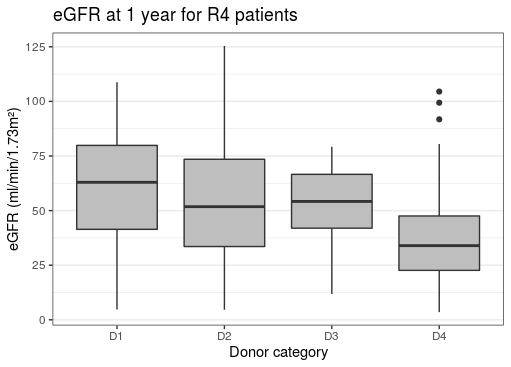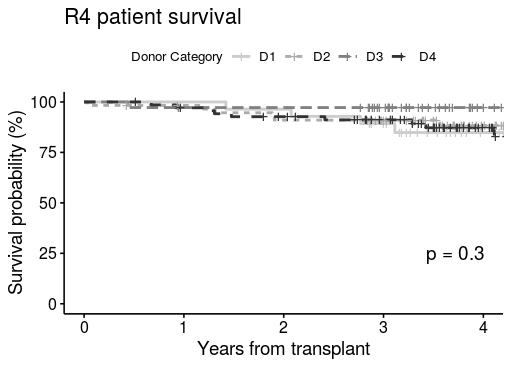The New UK National Kidney Allocation Scheme with Maximized ‘D4/R4’ Kidney Transplants: Appropriate Donor to Recipient Matching or System Overstretch?
Renal Transplant, Queen Elizabeth University Hospital, Glasgow, Glasgow, United Kingdom
Meeting: 2020 American Transplant Congress
Abstract number: B-019
Keywords: Allocation, Donors, marginal, Kidney transplantation, Length of stay
Session Information
Session Name: Poster Session B: Kidney Deceased Donor Allocation
Session Type: Poster Session
Date: Saturday, May 30, 2020
Session Time: 3:15pm-4:00pm
 Presentation Time: 3:30pm-4:00pm
Presentation Time: 3:30pm-4:00pm
Location: Virtual
*Purpose: The UK national deceased donor kidney matching scheme changed in September 2019, aiming to better match graft and patient survival. Donors and recipients are stratified into quartiles based on risk indices (D1-D4 for donors; R1-R4 for recipients; 4 is highest risk). We present data on two years of transplants aiming to highlight the potential impact on higher risk recipients.
*Methods: We reviewed all deceased donor transplants in our centre in 2015 and 2016. Recipients and donors were re-classified into the risk index quartiles: the donor risk index took into account donor age, height, length of hospital stay, cytomegalovirus (CMV) status, estimated glomerular filtration rate (eGFR), female sex and past medical history of hypertension; the recipient risk index was calculated using age, diabetes, dialysis status and duration. Endpoint data included total inpatient length of stay in the first year, one year eGFR, and patient and graft survival.
*Results: 196 deceased donor transplants were performed. 144 recipients (73.4%) were in the highest risk R4 category, including 55 with both R4 and D4 (38.1%). Within the R4 group, recipients receiving a D4 graft were associated with a higher rate of delayed graft function (DGF) vs D1-D3 grafts (41.7% vs 23.2%, p=0.009), longer index admission (median 11 days vs. 8 days) and more readmissions within the first post-operative year (28.5 vs 22.3 total inpatient days). Function at one year was lower with D4 grafts (mean eGFR 35.7, vs. 54.8, p=0.001), but there was no significant impact on R4 patient survival with D4 kidneys vs. D1-D3.
*Conclusions: The new matching scheme is designed to better match graft and patient survival. Our data suggests this will have a significant impact on transplant centres with resource burden front-loaded within the first post-operative year, but despite poorer graft function, patient survival appears to be satisfactory. Novel strategies to mitigate these outcomes may be critical to outcomes and avoiding logistical strain beyond that which the current overstretched system can deliver.
To cite this abstract in AMA style:
Pearson R, Murray E, Thompson P, Mark P, Clancy M, Asher J. The New UK National Kidney Allocation Scheme with Maximized ‘D4/R4’ Kidney Transplants: Appropriate Donor to Recipient Matching or System Overstretch? [abstract]. Am J Transplant. 2020; 20 (suppl 3). https://atcmeetingabstracts.com/abstract/the-new-uk-national-kidney-allocation-scheme-with-maximized-d4-r4-kidney-transplants-appropriate-donor-to-recipient-matching-or-system-overstretch/. Accessed December 14, 2025.« Back to 2020 American Transplant Congress


